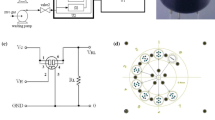Abstract
In this paper, hairtail (Trichiurus haumela) freshness determination method using electronic nose (EN) technology is discussed. Hairtail samples under different storage time are measured by EN. At the same time, physical/chemical indexes of hairtail samples, such as total volatile based nitrogen, total aerobic counts, pH, and texture characteristics, are also examined. The relationship between EN responses and physical/chemical indexes of the samples is discussed. Results indicate that principal component analysis method discriminates hairtail samples successfully. Stochastic resonance signal-to-noise ratio (SNR) eigen values qualitatively and quantitatively discriminate hairtail samples of different freshness. Hairtail freshness predicting model is developed using SNR eigen value non-linear fitting regression. The developed model forecasts freshness of hairtail samples with an accuracy of 90.48 %.








Similar content being viewed by others
References
C. Li, Hairtail fishes from Chinese coastal waters (Trichiuridea). Marine Sci. 4, 212–219 (1992)
L. Lin, H. Zhang, H. Li, J. Cheng, Study on seasonal variation of the feeding habits of hairtail (Trichiurus japonicus) in the East China Sea. Period. Ocean Univ. China 36, 932–936 (2006)
M. Peris, L. Escuder-Gilabert, A 21st century technique for food control: electronic noses. Anal. Chim. Acta 638, 1–15 (2009)
M.J. Lerma-Garcia, E.F. Simo-Alfonso, A. Bendini, L. Cerretani, Metal oxide semiconductor sensors for monitoring of oxidative status evolution and sensory analysis of virgin olive oils with different phenolic content. Food Chem. 117, 608–614 (2009)
J.A. Ragazzo-Sanchez, R. Chalier, D. Chevalier, M. Calderon-Santoyo, C. Ghommidh, Identification of different alcoholic beverages by electronic nose coupled to GC. Sens. Actuators, B 134, 43–48 (2008)
H. Reinhard, F. Sager, O. Zoller, Citrus juice classification by SPME-GC-MS and electronic nose measurements. Lwt-Food Sci. Technol. 41, 1906–1912 (2008)
J. Brezmes, E. Llobet, X. Vilanova, J. Orts, G. Saiz, X. Correig, Correlation between electronic nose signals and fruit quality indicators on shelf-life measurements with pinklady apples. Sens. Actuators, B 80, 41–50 (2001)
S. Benedetti, S. Buratti, A. Spinardi, S. Mannino, I. Mignani, Electronic nose as a non-destructive tool to characterise peach cultivars and to monitor their ripening stage during shelf-life. Postharvest Biol. Technol. 47, 181–188 (2008)
R. Dutta, E.L. Hines, J.W. Gardner, D.D. Udrea, P. Boilot, Non-destructive egg freshness determination: an electronic nose based approach. Meas. Sci. Technol. 14, 190–198 (2003)
K.S. McElyea, F.W. Pohlman, J.F. Meullenet, S. Suwansri, Evaluation of the electronic nose for rapid determination of meat freshness. Arkansas Animal Science Department Report 2003, AAES Research Series, vol 509 (2003), pp. 32–35.
X. Tang, X. Sun, V.C.H. Wu, J. Xie, Y. Pan, Y. Zhao, P.K. Malakar, Predicting shelf-life of chilled pork sold in China. Food Control 32, 334–340 (2013)
B. Shi, L. Zhao, R. Zhi, X. Xi, Optimization of electronic nose sensor array by genetic algorithms in Xihu-Longjing Tea quality analysis. Math. Comput. Model. 58, 752–758 (2013)
S. Gu, X. Wang, N. Tao, N. Wu, Characterization of volatile compounds in different edible parts of steamed Chinese mitten crab (Eriocheir sinensis). Food Res. Int. 54, 81–92 (2013)
China standard protocols, GB/T 5009.44-2003 (2003)
AOAC, Official Methods of Analysis, 17th edn. (Association of Official Analytical Chemists, Washington, 2002)
G.H. Hui, S.S. Mi, S.P. Deng, Sweet and bitter tastants specific detection by the taste cell-based sensor. Biosens. Bioelectron. 35, 429–438 (2012)
G.H. Hui, L.Y. Wang, Y.H. Mo, L.X. Zhang, Study of grass carp (Ctenopharyngodon idellus) quality predictive model based on electronic nose. Sens. Actuators, B 35, 301–308 (2012)
R. Benzi, A. Sutera, A. Vulpiana, The mechanism of stochastic resonance. J. Phys. A 14, L453–L456 (1981)
R. Dutta, A. Das, N.G. Stocks, D. Morgan, Stochastic resonance-based electronic nose: a novel way to classify bacteria. Sens. Actuators, B 115, 17–27 (2006)
L. Gammaitoni, P. Hanggi, P. Jung, F. Marchesoni, Stochastic resonance. Rev. Modern Phys. 70, 223–287 (1998)
G.H. Hui, Y.L. Wu, D.D. Ye, W.W. Ding, L.Y. Wang, Study of peach freshness predictive method based on electronic nose. Food Control 166–167, 25–32 (2012)
G.H. Hui, P. Ji, S.S. Mi, S.P. Deng, Electrochemical impedance spectrum frequency optimization of bitter taste cell-based sensors. Biosens. Bioelectron. 37, 164–170 (2013)
China standard protocols, GB 2733-2005 (2005)
Acknowledgments
This work is financially supported by National Natural Science Foundation of China (Grant No. 81000645), China Postdoctoral Science Foundation (Grant No. 2014M551749).
Author information
Authors and Affiliations
Corresponding author
Ethics declarations
Conflict of interest
Hui Guohua declares that he has no conflict of interest.
Rights and permissions
About this article
Cite this article
Han, L., Jinghao, J., Feixiang, Z. et al. Hairtail (Trichiurus haumela) freshness determination method based on electronic nose. Food Measure 9, 541–549 (2015). https://doi.org/10.1007/s11694-015-9262-3
Received:
Accepted:
Published:
Issue Date:
DOI: https://doi.org/10.1007/s11694-015-9262-3




